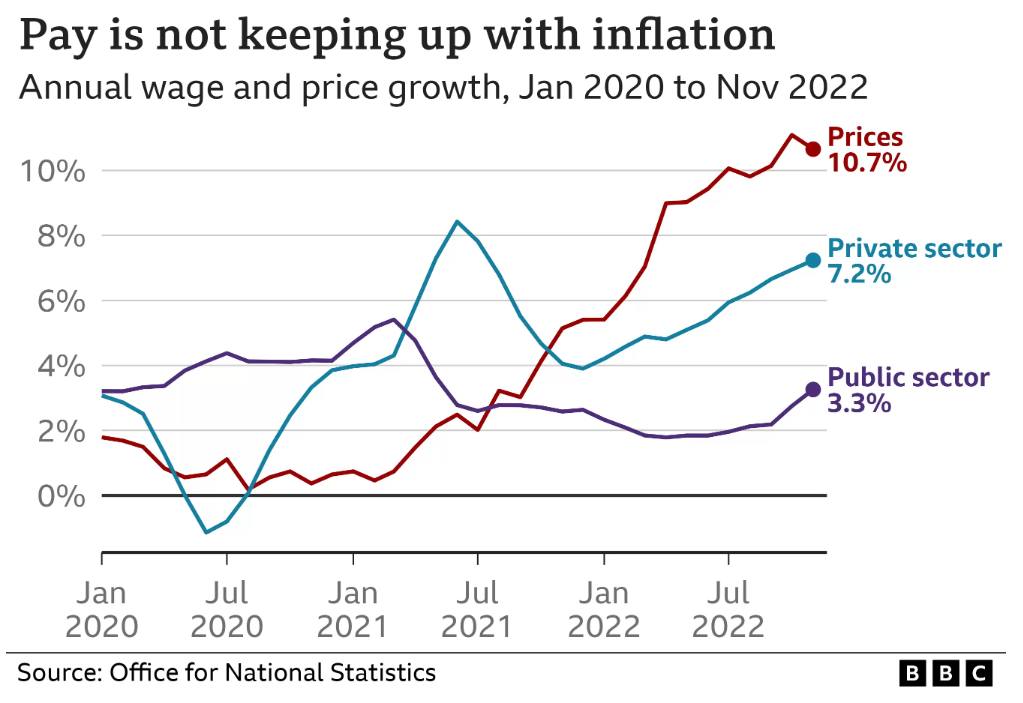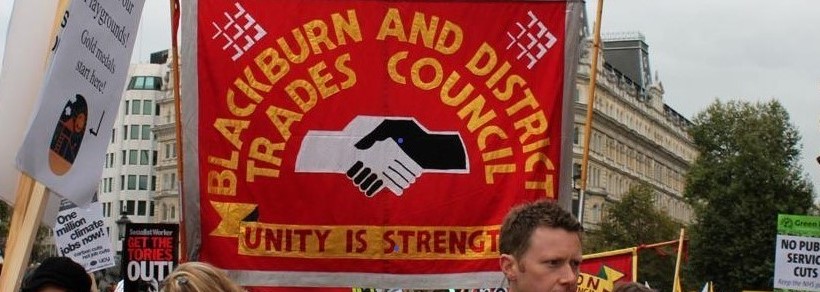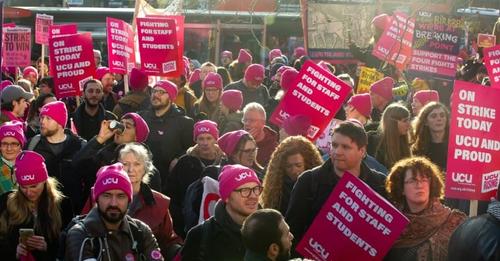The British Government, through H.M.Treasury, asserted to the public sector pay review bodies in December 2021 that satisfying public sector pay claims in 2022 would be “inflationary”, and it has stuck to that position ever since.
The argument it put forward, however, was not that such settlements would be inflationary in themselves. The proposition, instead, was that they would somehow spill over into, or encourage, higher wage demands across the economy. “If public sector pay increases were to exacerbate temporary inflationary pressure, for instance through spilling over into higher wage demands across the economy or contributing to higher inflation expectations,” they wrote, “then these short-term pressures would become more sustained”. At the time, also, the Government was still in thrall to a relaxed attitude to the prospect of inflation: “Inflation is expected to peak at around 4% in 2022 – its highest rate in over a decade – as a result of ongoing global supply chain issues and labour market shortages. However, the OBR and the Bank of England both expect this to be temporary, with a return of inflation to the 2% target underpinned by the UK’s strong and credible macroeconomic framework”.
It is clear that these ideas lost all contact with reality during 2022. Not only did inflation soar to over 10%, without public sector pay doing anything to encourage it, but pay claims in the wider economy paid no heed to what was happening in the public sector. Cost of living pressures were providing inspiration enough. If anything, it is the public sector that has been setting the pace – as this chart published by the BBC illustrates.

Of course, inflation does, to some degree represent a chain of events and a rise in public spending on wages could have a knock-on effect, depending in part on how other economic agents interact and on how it was paid for.
As Ben Zaranko, of IFS, wrote in “What should public sector pay policy be trying to achieve?” (July 2022): “For starters, it is difficult to see how an increase in public sector wages could directly contribute to a wage-price spiral, owing to the lack of prices in the public sector”.
“Of course, an increase in public sector pay would, unless accompanied by offsetting spending cuts or tax rises elsewhere, act to increase aggregate demand. All else being equal, we’d expect that to be inflationary at the margin. But the days of central government aiming to finetune demand in order to manage inflation are long gone. If higher aggregate demand is stoking higher inflation, we have a tool for that: higher interest rates”.
Tony Yates, an independent economist, and former Bank of England official told the “Financial Times” on 13/12/2022 that if a public sector pay rise appeared inflationary, the Bank of England could in any case offset it by raising interest rates. However, if the government funded higher pay by raising taxes, there would be no effect on inflation.
“The real objection is the ideological one, in particular the argument of the Tory party that doesn’t think [a bigger state] is consistent with conservatism,” he said.
Of greater significance to us, however, is the realisation that it matters where the Government intervenes in the web of economic interactions.
It is wage earners who have seen the longest pay squeeze in more than 200 years – with average pay still worth £85 a month less than in 2008. And in the public sector average pay is down by £204 a month in real terms compared to 2008.
Analysis of official statistics reveals that real wages (that is, wages after the cost of living has been considered) have slumped by 3.0% over the course of 2022. This is the sharpest fall in real wages since 1977 and the second worst on record since 1945. Working people have lost, on average, £76 a month in 2022 as a result of their pay not keeping pace with inflation.
Over the same period the experience of other economic agents has been very different.
According to the “New Economics Foundation” the wealth of the richest 10% of households has grown, over the last decade, 574 times faster than that of the poorest 10%, an increase of £2,722bn.

According to the “UK Dividend Monitor”, 2021’s total dividend payments came in 46% higher than 2020, when pay-outs fell to their lowest in almost a decade during the initial wave of the Covid-19 crisis (“Financial Times” 22/01/22). Prior to that, dividends had, unlike real wages, consistently risen from 2009 to 2019.
According to UNITE (“Corporate profiteering and the Cost of Living crisis), profit margins for Britain’s biggest listed companies (FTSE 350) in March 2022 were 73% higher than pre-pandemic levels in 2019.
Whilst consequences spinning out from Russia’s invasion of Ukraine have undoubtedly interacted badly with the global economy, the first signs of the current inflation were seen in the United States before these events and may relate to the pandemic “stimulus” package there or to how things have been playing out in terms of the relationship between the Chinese and American economies (China Covid Lockdowns Threaten To Fuel U.S. Inflation As Economic Pessimism Grows (forbes.com). We can see that a primary mechanism in the real economy, as identified by the “Economic Policy Institute” in America and UNITE in the UK, has been “fatter profit margins”.
As Economist Mariana Mazzucato told LBC in November 2022 (seen via this Twitter link: https://twitter.com/LBC/status/1588238615225798657?s=20&t=yvanypvyaynoFqXhXfd_aw)
inflation “can be due to non-unit labour costs, in other words food and energy prices, yes that’s one of the main sources but also excess profits in the system, which allows large companies in mining and in energy, to earn excess profits through very, very large mark ups and that is also one of the key sources right now of inflation”.

These explanations “fit” what we can see, but even if they are mistaken the different experiences of different people, according to their economic status, remains.
To separate out wage settlements as being “inflationary”, whilst taking no action with regards to all the other actors, is essentially to say that the buck stops with wage earners and that it is the workers who will be expected to come out of the various concatenations as the overall losers. Bond traders, bankers, landlords, FTSE 350 companies, dividend recipients – all these can “win”. The workers, though – they must be “responsible”, and lose.
What makes the Government’s determination to dump the costs of inflation onto the heads of workers even more galling is that there are several policies that might have the dual benefit of addressing any fiscal concerns whilst addressing some of the ways along which money finds itself moving to some parts of our society rather than others.
On October 24th, 2022, something quite extraordinary happened in the House of Commons. After a short debate, and with no division, it was agreed, amongst other things, to make an extra payment of just over £11bn to the Bank of England’s asset purchasing arm. This amount, close to that some have estimated would be the net cost of paying all public sector workers a cost of living pay rise, did not provoke an attack of the vapours on the Conservative benches or cause much anxiety about inflation.
This money was allocated to pay increased rates of interest on the central reserves created with the Bank of England for the commercial banks as part of the “Quantitative Easing” process.
There is a serious argument that these payments could be avoided, creating the fiscal space to satisfy public sector pay claims without increasing overall expenditure. “Positive Money” noted on their website on 9th November 2022: “Former Bank of England deputy governor Paul Tucker recently calculated that expected interest rate increases mean that banks will receive around £80 billion from the public purse over the next two years through this process. This was based on analysis from a brilliant New Economics Foundation report earlier this year, which argued that the government could save tens of billions of pounds a year by moving to a ‘tiered’ framework of reserve remuneration, rather than paying out the full base rate on all reserves banks hold with the Bank of England. This is a policy that has been implemented in the Eurozone, Japan and previously in the UK. Indeed, remunerating all reserves at the base rate is only a new development since 2009, and represents an aberration from the norm”.
It is not as if there is any sign that the banks will be seriously affected by denial of this unexpected “windfall”. The “Banker” website noted on 4th July 2022 that “All six banks were profitable in 2021, with Lloyds Bank reporting the largest upsurge, of 470.6%, and NatWest moving from loss to profit. The Banker editor Joy Macknight said: “After taking a profitability hit in 2020, the UK banking sector has rebounded and recorded a more than 200% increase in pre-tax profits….”.
“Positive Money” also observes that: “another alternative could be to tax banks for deposits not backed by reserves…….For example, banks could be charged a 2% tax on unreserved deposits, which would raise more than £25 billion a year for the UK government. A tax on banks should not be beyond the pale for a Conservative government – Margaret Thatcher imposed a windfall tax on the banks when they profited from higher interest rates in the 1980s”.
Beyond this, claims have been made for the ability of various taxation reforms to raise sufficient money to make increased spending on public sector pay “affordable” – with enough left over to direct into the sort of investment that Quantitative Easing failed to stimulate. We have not checked the feasibility of the amounts claimed, but surely they merit investigation:
- Would equalising the rates of capital gains tax with income tax rates bring in £16bn a year?
- Would extending national insurance contributions to investment income raise £14bn a year?
- Would equalising rates of dividend tax with income tax raise £7bn a year?
- Would Introducing an emergency 25% “windfall” tax on the buybacks of FTSE-listed companies raise £11 billion in a single year?
- Would an annual 1.5% tax on any wealth above £5m would raise £16bn?
Meanwhile, the “Tax Gap” (the difference between the amount of tax that should be collected, and the amount of tax actually collected) stood at £32bn in 2020-2021. A recent Public Accounts Committee Report (HMRC performance in 2021-22, Public Accounts Committee, 11 January 2023) noted that “for every £1 that HMRC spends on compliance activities, it recovers £18 in additional tax revenue”. Despite this, the Autumn 2022 budget saw an increase of only £15m per year to HMRC for compliance work, a paltry sum compared with the extra £112m per year the Department for Work and Pensions (DWP) is set to receive to tackle fraud and error.

